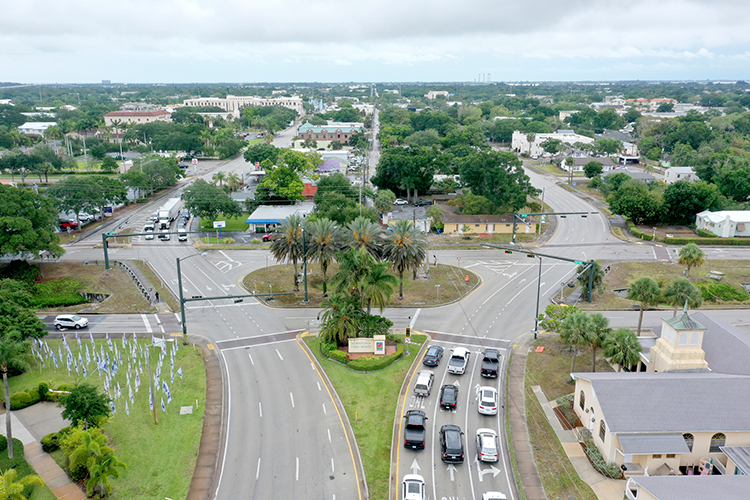
The engineering firm Vero Beach hired to help determine the feasibility of reducing lanes along the Twin Pairs through downtown was scheduled to begin work next week, but the recent rains could delay the start of the project until May 1.
The project, which the City Council approved last month, was postponed out of concern the Brightline-related railroad-crossing closures in the area would distort the data.
City Public Works Director Matthew Mitts said engineers in the local Kimley-Horn & Associates office decided to delay the traffic counts until the railroad crossings at 23rd Street, 26th Street and the 14th Avenue diagonal reopened.
The crossings, which have been closed since March 23, were scheduled to reopen tomorrow (Friday), but Brightline, citing factors that included weather, notified city officials Monday that its work there might not be finished until the end of next week.
“Those closures can drastically alter the downtown traffic pattern,” Mitts said, “so we’re going to wait until the crossings are open and things are back to normal.”
The traffic counts are expected to take three months to complete, and City Manager Monte Falls said he plans an analysis of the results to the City Council in July.
Mitts said the closures probably are pushing more traffic onto State Road 60 and reducing the number of vehicles traveling on downtown streets, producing artificial counts.
Delaying the start of the counts until next week – after many seasonal residents and visitors have left town – also is likely to impact the data, Mitts said, but the Florida Department of Transportation “has an approved method” that takes into account seasonal changes in traffic volume.
In addition to the traffic counts it records in the coming months, Kimley-Horn also will have access to data previously collected by the city and state, Mitts said, adding, “so we should get an accurate assessment.”
Three of the five City Council members have expressed strong support for reducing the Twin Pairs to two lanes in each direction as part of local efforts to revitalize downtown Vero.
In fact, the council voted 4-1 last month to spend up to $165,000 for a new study to determine whether the lane reduction is feasible, given the increasing volume of traffic along that heavily traveled stretch of State Road 60.
FDOT, which has approved a $6.7 million project to repave State Road 60 in 2026- 27 and is scheduled to embark on the design phase later this year, needs a firm decision from the city as soon as possible to accommodate any restriping.
In addition to the traffic study, FDOT also requires a City Council resolution endorsing the lane reduction and proof of community support.
The state agency would then decide during the summer of 2024 – after conducting public hearings in the community – whether to approve the lane reduction.
“Even with having to wait for the railroad crossings, we’ll still be able to submit a lane-reduction application in time,” Mitts said. “But we can’t have any unreasonable delays.
They want us to keep moving.”
Acting on Falls’ suggestion at their March 4 meeting, however, council members committed to only the first phase of what otherwise would be a comprehensive evaluation of the traffic along the Twin Pairs.
Falls said the study’s initial phase, which will cost more than $50,000, will involve collecting and analyzing traffic data with a goal of providing enough information to determine whether further evaluation is necessary.



